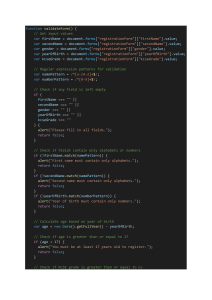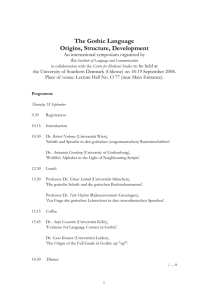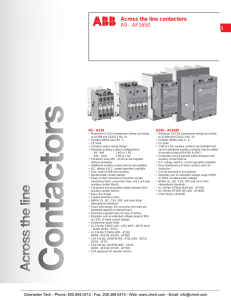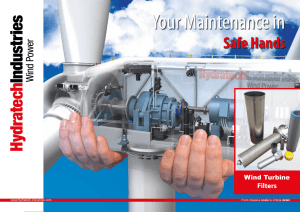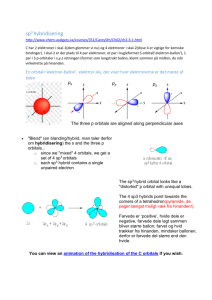Elektrisk sikkerhed, jording og returledning – Del 3
advertisement
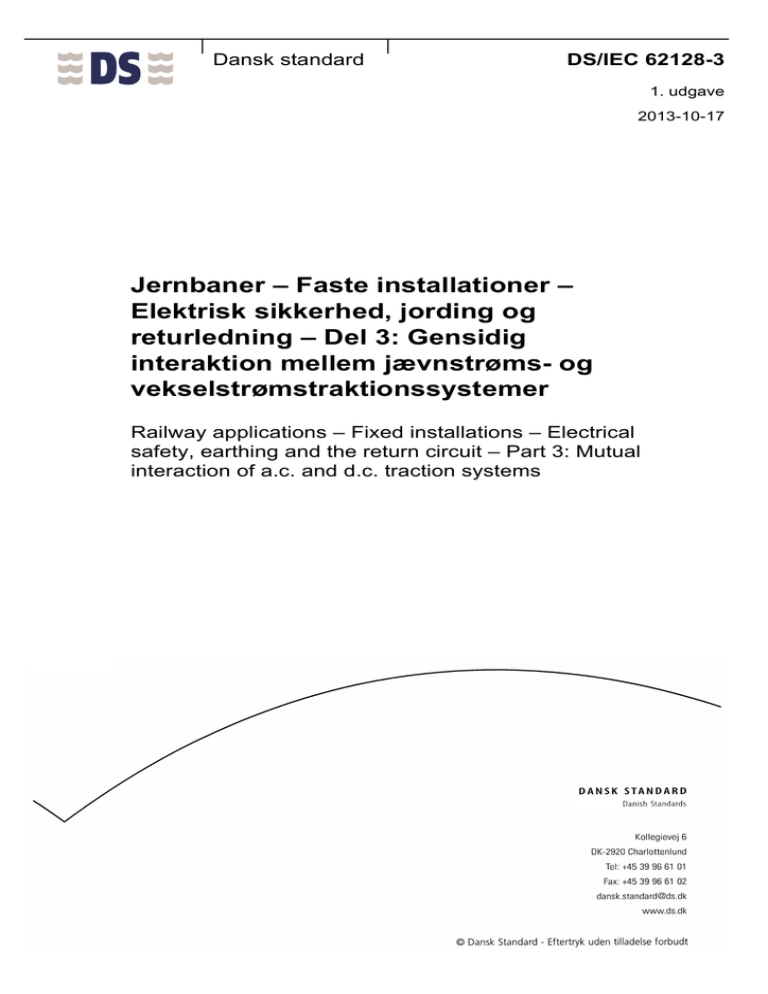
Dansk standard DS/IEC 62128-3 1. udgave 2013-10-17 Jernbaner – Faste installationer – Elektrisk sikkerhed, jording og returledning – Del 3: Gensidig interaktion mellem jævnstrøms- og vekselstrømstraktionssystemer Railway applications – Fixed installations – Electrical safety, earthing and the return circuit – Part 3: Mutual interaction of a.c. and d.c. traction systems COPYRIGHT © Danish Standards Foundation. Not for commercial use or reproduction. DS/IEC 62128-3:2013 DS/IEC 62128-3 København DS projekt: M262553 ICS: 45.060.01 Første del af denne publikations betegnelse er: DS/IEC, hvilket betyder, at det er en international standard, der har status som dansk standard. Denne publikations overensstemmelse er: IDT med: IEC 62128-3 ED 1.0:2013. DS-publikationen er på engelsk. DS-publikationstyper Dansk Standard udgiver forskellige publikationstyper. Typen på denne publikation fremgår af forsiden. Der kan være tale om: Dansk standard • standard, der er udarbejdet på nationalt niveau, eller som er baseret på et andet lands nationale standard, eller • standard, der er udarbejdet på internationalt og/eller europæisk niveau, og som har fået status som dansk standard DS-information • publikation, der er udarbejdet på nationalt niveau, og som ikke har opnået status som standard, eller • publikation, der er udarbejdet på internationalt og/eller europæisk niveau, og som ikke har fået status som standard, fx en teknisk rapport, eller • europæisk præstandard DS-håndbog • samling af standarder, eventuelt suppleret med informativt materiale DS-hæfte • publikation med informativt materiale Til disse publikationstyper kan endvidere udgives • tillæg og rettelsesblade DS-publikationsform Publikationstyperne udgives i forskellig form som henholdsvis • fuldtekstpublikation (publikationen er trykt i sin helhed) • godkendelsesblad (publikationen leveres i kopi med et trykt DS-omslag) • elektronisk (publikationen leveres på et elektronisk medie) DS-betegnelse Alle DS-publikationers betegnelse begynder med DS efterfulgt af et eller flere præfikser og et nr., fx DS 383, DS/EN 5414 osv. Hvis der efter nr. er angivet et A eller Cor, betyder det, enten at det er et tillæg eller et rettelsesblad til hovedstandarden, eller at det er indført i hovedstandarden. DS-betegnelse angives på forsiden. Overensstemmelse med anden publikation: Overensstemmelse kan enten være IDT, EQV, NEQ eller MOD • IDT: Når publikationen er identisk med en given publikation. • EQV: Når publikationen teknisk er i overensstemmelse med en given publikation, men præsentationen er ændret. • NEQ: Når publikationen teknisk eller præsentationsmæssigt ikke er i overensstemmelse med en given standard, men udarbejdet på baggrund af denne. • MOD: Når publikationen er modificeret i forhold til en given publikation. COPYRIGHT © Danish Standards Foundation. Not for commercial use or reproduction. DS/IEC 62128-3:2013 ® IEC 62128-3 Edition 1.0 2013-09 INTERNATIONAL STANDARD NORME INTERNATIONALE Railway applications – Fixed installations – Electrical safety, earthing and the return circuit – Part 3: Mutual interaction of a.c. and d.c. traction systems IEC 62128-3:2013 Applications ferroviaires – Installations fixes – Sécurité électrique, mise à la terre et circuit de retour – Partie 3: Interactions mutuelles entre systèmes de traction en courant alternatif et en courant continu COPYRIGHT © Danish Standards Foundation. Not for commercial use or reproduction. DS/IEC 62128-3:2013 –2– 62128-3 IEC:2013 CONTENTS FOREWORD ........................................................................................................................... 4 1 Scope ............................................................................................................................... 6 2 Normative references ....................................................................................................... 7 3 Terms and definitions ....................................................................................................... 7 4 Hazards and adverse effects ............................................................................................ 7 5 4.1 General ................................................................................................................... 7 4.2 Electrical safety of persons ..................................................................................... 7 Types of mutual interaction to be considered .................................................................... 7 5.1 5.2 6 General ................................................................................................................... 7 Galvanic coupling .................................................................................................... 8 5.2.1 AC and d.c. return circuits not directly connected ........................................ 8 5.2.2 AC and d.c. return circuits directly connected or common ............................ 8 5.3 Non-galvanic coupling ............................................................................................. 9 5.3.1 Inductive coupling ........................................................................................ 9 5.3.2 Capacitive coupling ..................................................................................... 9 Zone of mutual interaction ................................................................................................ 9 7 6.1 General ................................................................................................................... 9 6.2 AC ........................................................................................................................... 9 6.3 DC ........................................................................................................................ 10 Touch voltage limits for the combination of alternating and direct voltages ..................... 10 8 7.1 General ................................................................................................................. 10 7.2 Touch voltage limits for long-term conditions ......................................................... 11 7.3 AC system short-term conditions and d.c. system long-term conditions ................. 12 7.4 AC system long-term conditions and d.c. system short-term conditions ................. 13 7.5 AC system short-term conditions and d.c. system short-term conditions ................ 14 7.6 Workshops and similar locations ........................................................................... 14 Technical requirements and measures inside the zone of mutual interaction .................. 15 8.1 8.2 General ................................................................................................................. 15 Requirements if the a.c. railway and the d.c. railway have separate return circuits .................................................................................................................. 15 8.2.1 General ..................................................................................................... 15 8.2.2 Return circuit or parts connected to the return circuit located in the OCLZ and/or CCZ of the other system ....................................................... 15 8.2.3 Common buildings and common structures ................................................ 16 8.2.4 Inductive and capacitive coupling .............................................................. 17 8.3 Requirements if the a.c. railway and the d.c. railway have common return circuits and use the same tracks ........................................................................... 17 8.3.1 General ..................................................................................................... 17 8.3.2 Measures against stray current .................................................................. 17 8.3.3 Common structures and common buildings ................................................ 18 8.3.4 Exceptions ................................................................................................. 18 8.3.5 Design of overhead contact line ................................................................. 18 8.3.6 Inductive and capacitive coupling .............................................................. 18 8.4 System separation sections and system separation stations .................................. 18 Annex A (informative) Zone of mutual interaction ................................................................. 20 Annex B (informative) Analysis of combined voltages .......................................................... 26 COPYRIGHT © Danish Standards Foundation. Not for commercial use or reproduction. DS/IEC 62128-3:2013 62128-3 IEC:2013 –3– Annex C (informative) Analysis and assessment of mutual interaction ................................. 31 Bibliography .......................................................................................................................... 32 Figure 1 – Maximum permissible combined effective touch voltages (excluding workshops and similar locations) for long-term conditions ..................................................... 12 Figure 2 – Maximum permissible combined effective touch voltages under a.c. shortterm conditions and d.c. long-term conditions ....................................................................... 13 Figure 3 – Maximum permissible combined effective touch voltages under a.c. longterm conditions and d.c. short-term conditions ...................................................................... 14 Figure 4 – Maximum permissible combined effective touch voltages in workshops and similar locations excluding short-term conditions................................................................... 15 Figure 5 – Example of where a VLD shall be suitable for both alternating and direct voltage .................................................................................................................................. 16 Figure A.1 – Overview of voltages coupled as function of distance and soil resistivity I ........ 21 Figure A.2 – Overview of voltages coupled as function of distance and soil resistivity II ....... 22 Figure A.3 – Relation between length of parallelism and zone of mutual interaction caused by an a.c. railway ...................................................................................................... 23 Figure B.1 – Definition of combined peak voltage.................................................................. 27 Figure B.2 – Overview of permissible combined a.c. and d.c. voltages .................................. 28 Figure B.3 – Overview of permissible voltages in case of a duration ≥ 1,0 s for both a.c. voltage and d.c. voltage ................................................................................................. 29 Figure B.4 – Permissible voltages in case of a duration of 0,1 s a.c. voltage and a duration of 300 s d.c. voltage ................................................................................................ 30 COPYRIGHT © Danish Standards Foundation. Not for commercial use or reproduction. DS/IEC 62128-3:2013 –4– 62128-3 IEC:2013 INTERNATIONAL ELECTROTECHNICAL COMMISSION ____________ RAILWAY APPLICATIONS – FIXED INSTALLATIONS – ELECTRICAL SAFETY, EARTHING AND THE RETURN CIRCUIT – Part 3: Mutual interaction of a.c. and d.c. traction systems FOREWORD 1) The International Electrotechnical Commission (IEC) is a worldwide organization for standardization comprising all national electrotechnical committees (IEC National Committees). The object of IEC is to promote international co-operation on all questions concerning standardization in the electrical and electronic fields. To this end and in addition to other activities, IEC publishes International Standards, Technical Specifications, Technical Reports, Publicly Available Specifications (PAS) and Guides (hereafter referred to as “IEC Publication(s)”). Their preparation is entrusted to technical committees; any IEC National Committee interested in the subject dealt with may participate in this preparatory work. International, governmental and nongovernmental organizations liaising with the IEC also participate in this preparation. IEC collaborates closely with the International Organization for Standardization (ISO) in accordance with conditions determined by agreement between the two organizations. 2) The formal decisions or agreements of IEC on technical matters express, as nearly as possible, an international consensus of opinion on the relevant subjects since each technical committee has representation from all interested IEC National Committees. 3) IEC Publications have the form of recommendations for international use and are accepted by IEC National Committees in that sense. While all reasonable efforts are made to ensure that the technical content of IEC Publications is accurate, IEC cannot be held responsible for the way in which they are used or for any misinterpretation by any end user. 4) In order to promote international uniformity, IEC National Committees undertake to apply IEC Publications transparently to the maximum extent possible in their national and regional publications. Any divergence between any IEC Publication and the corresponding national or regional publication shall be clearly indicated in the latter. 5) IEC itself does not provide any attestation of conformity. Independent certification bodies provide conformity assessment services and, in some areas, access to IEC marks of conformity. IEC is not responsible for any services carried out by independent certification bodies. 6) All users should ensure that they have the latest edition of this publication. 7) No liability shall attach to IEC or its directors, employees, servants or agents including individual experts and members of its technical committees and IEC National Committees for any personal injury, property damage or other damage of any nature whatsoever, whether direct or indirect, or for costs (including legal fees) and expenses arising out of the publication, use of, or reliance upon, this IEC Publication or any other IEC Publications. 8) Attention is drawn to the Normative references cited in this publication. Use of the referenced publications is indispensable for the correct application of this publication. 9) Attention is drawn to the possibility that some of the elements of this IEC Publication may be the subject of patent rights. IEC shall not be held responsible for identifying any or all such patent rights. International Standard IEC 62128-3 has been prepared by IEC technical committee 9: Electrical equipment and systems for railways. This standard is based on EN 50122-3. The text of this standard is based on the following documents: FDIS Report on voting 9/1805/FDIS 9/1838/RVD Full information on the voting for the approval of this standard can be found in the report on voting indicated in the above table. COPYRIGHT © Danish Standards Foundation. Not for commercial use or reproduction. DS/IEC 62128-3:2013 62128-3 IEC:2013 –5– This publication has been drafted in accordance with the ISO/IEC Directives, Part 2. A list of all parts in the IEC 62128 series, published under the general title Railway applications – Fixed installations – Electrical safety, earthing and the return circuit, can be found on the IEC website. The committee has decided that the contents of this publication will remain unchanged until the stability date indicated on the IEC web site under "http://webstore.iec.ch" in the data related to the specific publication. At this date, the publication will be • reconfirmed, • withdrawn, • replaced by a revised edition, or • amended. COPYRIGHT © Danish Standards Foundation. Not for commercial use or reproduction. DS/IEC 62128-3:2013 –6– 62128-3 IEC:2013 RAILWAY APPLICATIONS – FIXED INSTALLATIONS – ELECTRICAL SAFETY, EARTHING AND THE RETURN CIRCUIT – Part 3: Mutual interaction of a.c. and d.c. traction systems 1 Scope This part of IEC 62128 specifies requirements for the protective provisions relating to electrical safety in fixed installations, when it is reasonably likely that hazardous voltages or currents will arise for people or equipment, as a result of the mutual interaction of a.c. and d.c. electric traction systems. It also applies to all aspects of fixed installations that are necessary to ensure electrical safety during maintenance work within electric traction systems. The mutual interaction can be of any of the following kinds: – parallel running of a.c. and d.c. electric traction systems; – crossing of a.c. and d.c. electric traction systems; – shared use of tracks, buildings or other structures; – system separation sections between a.c. and d.c. electric traction systems. Scope is limited to basic frequency voltages and currents and their superposition. This standard does not cover radiated interferences. This standard applies to all new lines, extensions and to all major revisions to existing lines for the following electric traction systems: a) railways; b) guided mass transport systems such as: 1) tramways, 2) elevated and underground railways, 3) mountain railways, 4) trolleybus systems, and 5) magnetically levitated systems, which use a contact line system; c) material transportation systems. The standard does not apply to: d) mine traction systems in underground mines; e) cranes, transportable platforms and similar transportation equipment on rails, temporary structures (e.g. exhibition structures) in so far as these are not supplied directly or via transformers from the contact line system and are not endangered by the traction power supply system for railways; f) suspended cable cars; g) funicular railways; h) procedures or rules for maintenance. The rules given in this standard can also be applied to mutual interaction with non-electrified tracks, if hazardous voltages or currents can arise from a.c. or d.c. electric traction systems. COPYRIGHT © Danish Standards Foundation. Not for commercial use or reproduction. DS/IEC 62128-3:2013 62128-3 IEC:2013 2 –7– Normative references The following documents, in whole or in part, are normatively referenced in this document and are indispensable for its application. For dated references, only the edition cited applies. For undated references, the latest edition of the referenced document (including any amendments) applies. IEC 62128-1:2013, Railway applications – Fixed installations – Electrical safety, earthing and the return circuit – Part 1: Protective provisions against electric shock IEC 62128-2:2013, Railway applications – Fixed installations – Electrical safety, earthing and the return circuit – Part 2: Provisions against the effects of stray currents caused by d.c. traction systems 3 Terms and definitions For the purposes of this document, the terms and definitions given in IEC 62128-1 apply. 4 4.1 Hazards and adverse effects General The different requirements specified in IEC 62128-1 and IEC 62128-2, concerning connections to the return circuit of the a.c. railway, and connections to the return circuit of the d.c. railway, shall be harmonized in order to avoid risks of hazardous voltages and stray currents. Such hazards and risks shall be considered from the start of the planning of any installation which includes both a.c. and d.c. railways. Suitable measures shall be specified for limiting the voltages to the levels given in this standard, while limiting the damaging effects of stray currents in accordance with IEC 62128-2. Additional adverse effects are possible, for example: – thermal overload of conductors, screens and sheaths; – thermal overload of transformers due to magnetic saturation of the cores; – restriction of operation because of possible effects on the safety and correct functioning of signalling systems; – restriction of operation because of malfunction of the communication system. These effects should be considered in accordance with the appropriate standards. 4.2 Electrical safety of persons Where a.c. and d.c. voltages are present together the limits for touch voltage given in Clause 7 apply in addition to the limits given in IEC 62128-1:2013, Clause 9. 5 5.1 Types of mutual interaction to be considered General Coupling describes the physical process of transmission of energy from a source to a susceptible device. The following types of coupling shall be considered:
